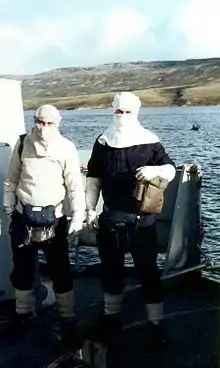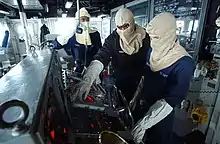Anti-flash gear
Anti-flash gear, also known simply as flash gear, is basic personal protective equipment consisting of a fire-resistant hood and fire-resistant gloves,[1] often made of Nomex.


The purpose of anti-flash gear is to provide protection to the head, neck, face and hands from short-duration flame exposure and heat. This equipment is donned by shipboard navy personnel whenever a fire breaks out or during periods of heightened readiness.[1]
History
Anti-flash gear was introduced in the Royal Navy following the Battle of Jutland,[2] when a number of British warships had been destroyed or damaged by flash from burning cordite propellant passing through the shell handling room into the magazine. It was found that the anti-flash hoods and gloves were more effective if flame-proofed with borax or boric acid.[3]
References
- NAVEDTRA 14057, Damage Controlman (PDF). Naval Education and Training Professional Development and Training Center. 2001-04-01.
- Hough, Richard (1983). The Great War at Sea, 1914-1918. Oxford University Press. p. 223. ISBN 9780192158710.
- Australia in the war of 1939-1945: Ser. 5. Medical, Volume 4. Australian War Memorial. 1961. p. 122.
External links
- "Royal Navy gunner with flash vizor on HMS Hermes in 1982". paimages.co.uk. Retrieved 7 December 2017.
- "Anti-flash balaclava helmet in IWM Collection". iwm.org.uk. Retrieved 7 December 2017.